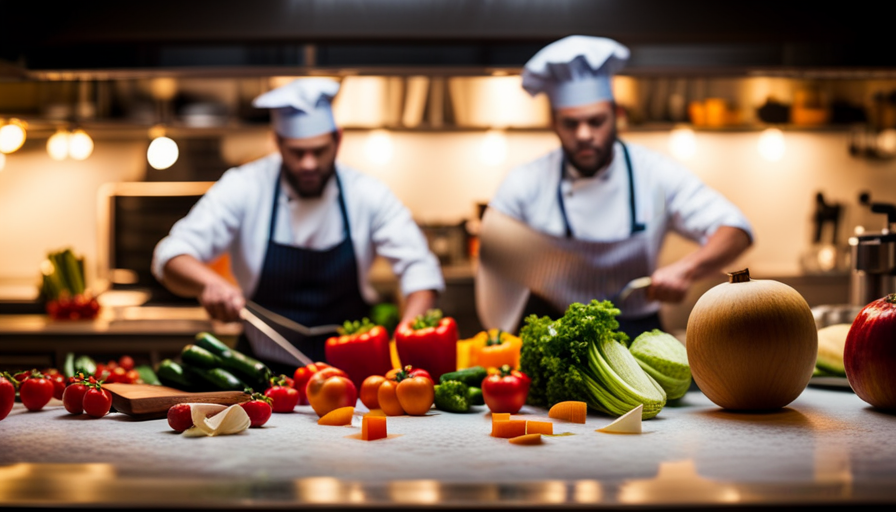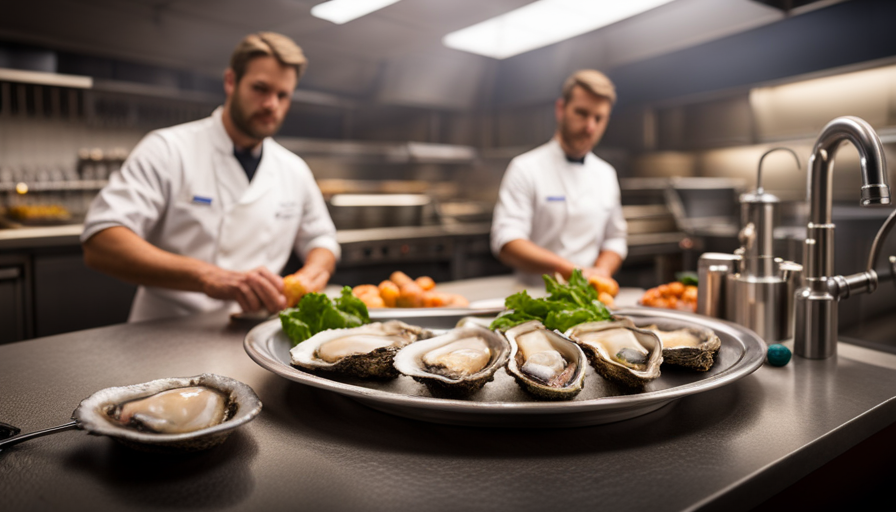Have you ever heard the expression, ‘You are what you eat’? Well, when it comes to raw food, that saying takes on a whole new meaning. Raw food, despite being promoted as a healthy and natural way of eating, can actually be dangerous if not handled or prepared correctly.
It’s like playing with fire – one wrong move and you could get burned. In this article, we will delve into the science behind the toxicity of raw foods, explore the deadly raw foods to avoid, and uncover the reasons behind their toxicity.
But fear not, there is a solution – cooking! We will also discuss the cooking methods that neutralize toxins and the importance of proper food handling and storage.
So, if you’re ready to learn about the hidden dangers of raw food and how cooking can save the day, then let’s dive in!
Key Takeaways
- Cooking raw food can neutralize toxins and increase safety for consumption
- Cooking raw fish kills harmful organisms and makes it safe to eat
- Proper cooking methods can kill harmful bacteria in raw meat, eggs, and shellfish
- Fermentation and pickling can break down toxins and enhance flavor in raw foods
The Science Behind Toxicity in Raw Foods
Did you ever wonder why certain raw foods can be deadly, but become safe to eat once cooked? The answer lies in the science behind toxicity in raw foods.
One example of this is raw fish. Raw fish, such as sushi and sashimi, can contain harmful bacteria and parasites like salmonella and tapeworms. These organisms can cause food poisoning and other serious health issues. However, when raw fish is cooked to the appropriate temperature, these harmful organisms are killed, making it safe to consume.
Another example is vegetables. While raw vegetables are generally safe to eat, cooking them can provide additional benefits. Cooking vegetables can break down tough fibers, making them easier for our bodies to digest. It can also enhance the bioavailability of certain nutrients, such as lycopene in tomatoes, which is better absorbed by the body when cooked. Additionally, cooking vegetables can help destroy harmful bacteria that may be present on the surface.
Cooking certain raw foods can eliminate potential toxins and increase their safety for consumption. Now that we understand the science behind the toxicity of raw foods and the benefits of cooking vegetables, let’s explore some specific deadly raw foods to avoid.
Deadly Raw Foods to Avoid
Avoiding certain uncooked ingredients can keep you safe from the potential dangers that lurk in your plate. Raw foods can pose toxicity risks and increase the chances of foodborne illnesses. To ensure your well-being, it’s important to be aware of the deadly raw foods that should be avoided.
One such food is raw meat. Consuming raw or undercooked meat can expose you to harmful bacteria like Salmonella, E. coli, and Campylobacter. These bacteria can cause severe gastrointestinal infections, leading to symptoms such as diarrhea, abdominal pain, and vomiting.
Another dangerous raw food is unpasteurized milk. It can contain harmful bacteria like Listeria, which can cause serious illness, especially in pregnant women, newborns, and those with weakened immune systems.
Raw eggs are also a significant source of foodborne illness. They can be contaminated with Salmonella, resulting in symptoms like fever, nausea, and diarrhea.
Additionally, raw shellfish, such as oysters and clams, can contain the Vibrio bacteria, which can lead to severe infections.
Understanding the risks associated with these deadly raw foods is crucial for your safety. In the next section, we’ll explore the reasons behind raw food toxicity, shedding light on the science behind these potential dangers.
Reasons Behind Raw Food Toxicity
By consuming uncooked ingredients, you are putting yourself at risk of experiencing the harmful effects of toxic substances lurking in your plate. Raw food safety is a critical concern, as certain foods can contain natural toxins that can be neutralized through cooking methods. The reasons behind raw food toxicity are varied and include the presence of harmful bacteria, parasites, and natural toxins.
To provide a visual representation of these ideas, consider the following table:
| Raw Food Safety | Raw Food Preparation |
|---|---|
| Proper handling and storage of raw ingredients | Thoroughly washing fruits and vegetables |
| Avoiding cross-contamination between raw and cooked foods | Using separate cutting boards and utensils for raw and cooked foods |
| Cooking meat and seafood to appropriate internal temperatures | Using a food thermometer to ensure proper cooking |
Following these practices can significantly reduce the risk of foodborne illnesses associated with raw food consumption. It is important to note that cooking methods, such as heat treatment, can neutralize toxins present in raw foods. This transition sets the stage for the subsequent section, which will discuss cooking methods that effectively neutralize these toxins without compromising the nutritional value of the food.
Cooking Methods that Neutralize Toxins
When it comes to neutralizing toxins in raw food, there are a few cooking methods that have proven to be effective. Heat-based cooking methods, such as boiling or grilling, can help kill harmful bacteria and other pathogens that may be present in the food.
Fermentation and pickling are also great options, as they involve the use of beneficial bacteria that can help break down toxins and make the food safer to consume.
Heat-based cooking methods
Cooking food using heat-based methods is like a magical transformation that turns potentially deadly ingredients into delicious and safe meals. These cooking techniques not only help in neutralizing toxins but also enhance the flavor of the food.
Heat-based cooking methods such as boiling, steaming, baking, and grilling involve subjecting the food to high temperatures, which effectively kills harmful bacteria and parasites that may be present. The heat also breaks down complex proteins, making them more easily digestible.
Additionally, cooking food can enhance the flavors by releasing natural sugars and caramelizing the surface, resulting in a more enjoyable eating experience.
Moving on to the next section about fermentation and pickling, these traditional preservation methods offer yet another way to transform raw ingredients into flavorful and safe dishes.
Fermentation and pickling
Fermentation and pickling add a burst of flavor and transform ingredients into delectable dishes. These ancient preservation techniques have numerous benefits, including enhancing the nutritional value of food and promoting gut health. Here are three reasons why fermentation and pickling are worth exploring:
-
Probiotics: Fermented foods like sauerkraut and kimchi are rich in beneficial bacteria that support a healthy digestive system.
-
Increased nutrient availability: Fermentation breaks down complex compounds, making nutrients more accessible and easier to absorb.
-
Extended shelf life: Pickling preserves food by creating an acidic environment that inhibits the growth of harmful bacteria, extending the longevity of perishable ingredients.
Understanding the benefits of fermentation and pickling highlights the importance of proper food handling and storage. It’s crucial to ensure that these techniques are done correctly to prevent foodborne illnesses.
Importance of Proper Food Handling and Storage
When it comes to food handling and storage, proper hygiene practices are crucial in preventing contamination. By washing hands thoroughly before and after handling food, we can reduce the risk of spreading harmful bacteria.
Additionally, storing raw foods correctly, such as keeping them at the right temperature and separating them from ready-to-eat foods, helps maintain freshness and prevents cross-contamination.
These simple yet important steps can go a long way in ensuring the safety and quality of our food.
Hygiene practices to prevent contamination
To ensure your safety and protect against harmful bacteria, it’s essential to maintain proper hygiene practices. This includes proper handwashing and taking measures to prevent cross-contamination. Here are some important hygiene practices to follow:
- Wash your hands thoroughly with soap and water before handling any food.
- Use separate cutting boards and utensils for raw and cooked foods to avoid cross-contamination.
- Clean and sanitize countertops and kitchen surfaces regularly, especially after handling raw meats or eggs.
- Store raw foods in sealed containers in the refrigerator to prevent bacteria growth.
By following these hygiene practices, you can reduce the risk of foodborne illnesses and keep yourself and your loved ones safe.
Now, let’s move on to the next section about storing raw foods correctly to maintain freshness.
Storing raw foods correctly to maintain freshness
To ensure that raw foods remain fresh and uncontaminated, proper storage practices are crucial. By storing raw foods correctly, we can maintain their freshness for longer periods of time and minimize the risk of bacterial growth. The best storage practices for different types of raw foods may vary, but there are some general guidelines to follow. For example, raw meats should be stored in the refrigerator at temperatures below 40°F (4°C) to prevent the growth of harmful bacteria. Fruits and vegetables should be stored in the crisper drawer of the refrigerator to maintain their freshness and prevent wilting. Additionally, it is important to separate raw meats from other foods to prevent cross-contamination. By following these best storage practices, we can ensure that our raw foods remain fresh and safe to consume. Transitioning into the next section, let’s now explore the health benefits of cooking raw foods.
Health Benefits of Cooking Raw Foods
Cooking raw foods unlocks a world of health benefits that can transform your well-being and leave you feeling vibrant and alive. Here are four cooking techniques that not only enhance the flavor of your food but also reduce health risks associated with consuming raw foods:
-
Killing harmful bacteria: Cooking raw foods at high temperatures helps eliminate bacteria such as Salmonella and E. coli, which can cause severe foodborne illnesses. By properly cooking your food, you can significantly reduce the risk of these infections.
-
Improved nutrient absorption: Cooking certain raw foods can increase the bioavailability of essential nutrients. For example, cooking tomatoes enhances the absorption of lycopene, a powerful antioxidant linked to reducing the risk of certain cancers.
-
Enhanced digestion: Cooking breaks down the tough fibers in raw foods, making them easier to digest. This can be particularly beneficial for individuals with sensitive stomachs or digestive issues.
-
Increased nutrient variety: By cooking a variety of raw foods, you can diversify your nutrient intake. Different cooking techniques unlock unique flavors and textures, allowing you to enjoy a wider range of nutrients.
Understanding the health benefits of cooking raw foods sets the stage for addressing common misconceptions about raw food diets.
Common Misconceptions about Raw Food Diets
When it comes to raw food diets, there are a few common misconceptions that need to be addressed. One of them is the idea that raw food diets can effectively detoxify the body. While raw fruits and vegetables do provide essential nutrients, there is no scientific evidence to support the claim that they can detoxify the body.
Additionally, some believe that raw food diets are an effective way to lose weight. While it’s true that a diet high in raw fruits and vegetables can be low in calories and help with weight loss, it’s not a guaranteed method and should be approached with caution.
Raw food diets and detoxification
Imagine feeling lighter and more energized as you embrace a raw food diet, allowing your body to naturally detoxify and reset, like a sparkling clean river flowing through your veins. Raw food diets have been touted for their detoxification benefits, which can lead to long-term effects on overall health. By consuming raw fruits, vegetables, and nuts, you provide your body with essential nutrients and enzymes that support the detoxification process. These foods are rich in fiber, which aids in digestion and helps eliminate toxins from the body. Additionally, raw foods are typically low in sodium and processed sugars, reducing the burden on your liver and kidneys. Incorporating a variety of raw foods into your diet can support your body’s natural detoxification processes and promote optimal health. Transitioning into the subsequent section about ‘raw food diets and weight loss’, you’ll discover the additional benefits of this lifestyle.
Raw food diets and weight loss
When it comes to raw food diets, weight loss is often touted as one of the major benefits. Advocates claim that the high fiber content and lower calorie density of raw foods can lead to a decrease in overall calorie intake and, consequently, weight loss. However, it’s important to consider the impact of raw food on digestion and nutrient absorption.
Raw foods can be harder to digest due to their higher fiber content, which may lead to bloating and discomfort in some individuals. Additionally, certain nutrients in raw foods, such as iron and calcium, are better absorbed when cooked. Therefore, while raw food diets may initially promote weight loss, it’s crucial to ensure adequate nutrient intake and consider individual digestive capabilities.
Transitioning to the subsequent section about the nutritional value of cooked foods, it’s important to explore how cooking methods can enhance nutrient absorption.
Nutritional Value of Cooked Foods
Cooked foods offer you a higher nutritional value compared to their raw counterparts, allowing you to savor the delicious flavors while nourishing your body.
While it’s true that cooking can lead to some nutrient loss, it also enhances the availability of certain essential nutrients. For example, cooking can increase the bioavailability of antioxidants, such as lycopene in tomatoes and beta-carotene in carrots. This means that your body can absorb and utilize these nutrients more effectively when they’re cooked.
Additionally, cooking can help break down the cell walls of plants, making it easier for your body to access the nutrients inside.
Cooking also has a positive impact on food texture. It can soften tough fibers and make food easier to chew and digest. For example, boiling or steaming vegetables can make them more tender and palatable, while also preserving their nutritional content.
The process of cooking can also enhance the flavors of foods, making them more enjoyable to eat.
As we delve deeper into the topic of safe cooking temperatures and times, it’s important to understand the benefits that cooking brings to our food.
Safe Cooking Temperatures and Times
To ensure the safety of your meal, it’s crucial to familiarize yourself with the recommended cooking temperatures and times, just like a seasoned chef would do. By following safe cooking techniques and ensuring that your food reaches the appropriate temperatures, you can greatly reduce the risk of foodborne illnesses.
Here are four important things to keep in mind when it comes to safe cooking temperatures:
-
Use a food thermometer: This handy tool allows you to accurately measure the internal temperature of your food, ensuring that it has reached a safe level to kill any harmful bacteria.
-
Know the recommended temperatures: Different types of food have different safe cooking temperatures. For example, poultry should be cooked to an internal temperature of 165°F (74°C), while ground meats should reach 160°F (71°C).
-
Use the right cooking times: Cooking times can vary depending on the type and size of the food. It’s important to follow recommended cooking times to ensure that the food is thoroughly cooked.
-
Avoid cross-contamination: To prevent the spread of bacteria, make sure to clean cutting boards, utensils, and countertops after they come into contact with raw meat or poultry.
By understanding these safe cooking techniques and recommended cooking temperatures, you can confidently prepare meals that are both delicious and safe.
Transitioning into the next section about promoting food safety in the kitchen, it’s important to take additional steps to ensure the overall safety of your food.
Promoting Food Safety in the Kitchen
By implementing proper hygiene practices and adhering to food safety guidelines, you can create a kitchen environment that promotes the overall safety and well-being of your meals.
Promoting kitchen cleanliness is crucial in preventing the spread of harmful bacteria and ensuring the safety of the food you prepare. Start by washing your hands thoroughly with soap and warm water before handling any ingredients. This simple step helps remove any potential pathogens from your hands and prevents cross-contamination.
To further promote kitchen cleanliness, regularly clean and sanitize all surfaces and utensils that come into contact with food. Use hot, soapy water to wash cutting boards, knives, and countertops after each use. Additionally, sanitize these surfaces with a bleach solution or a food-grade sanitizer to kill any remaining bacteria.
Preventing cross-contamination is another essential aspect of promoting food safety in the kitchen. Keep raw meats, poultry, and seafood separate from ready-to-eat foods to avoid the transfer of harmful bacteria. Use separate cutting boards and utensils for raw and cooked foods, and never reuse marinades or sauces that have come into contact with raw meats.
By following these guidelines and maintaining a clean and organized kitchen, you can minimize the risk of foodborne illnesses and ensure the safety of the meals you prepare. Remember, promoting kitchen cleanliness and preventing cross-contamination are vital steps in creating a healthy and safe cooking environment.
Frequently Asked Questions
What are the potential health risks associated with consuming raw foods?
Consuming raw foods can pose potential health risks. Raw foods have the potential to harbor harmful bacteria, such as salmonella and E. coli, which can cause foodborne illnesses. Additionally, certain raw foods contain natural toxins that can be harmful when ingested.
However, it’s important to note that raw foods also offer potential benefits, including increased nutritional value and preservation of heat-sensitive vitamins and enzymes. Therefore, it’s essential to properly handle, wash, and cook raw foods to minimize these risks.
Are there any specific raw foods that are known to be more dangerous than others?
Raw food safety precautions are important to prevent common raw foodborne illnesses. While all raw foods carry some risk, certain foods are known to be more dangerous.
For example, raw meat and poultry can contain harmful bacteria like Salmonella and E. coli, while raw seafood may harbor parasites. Additionally, raw sprouts have been linked to outbreaks of E. coli and Salmonella.
It’s crucial to handle, store, and prepare raw foods properly to minimize the risk of illness.
How does cooking neutralize toxins in raw foods?
Cooking neutralizes toxins in raw foods through various cooking techniques, such as heat and chemical reactions. The benefits of cooking include denaturing harmful enzymes and proteins, breaking down complex carbohydrates for easier digestion, and killing harmful bacteria.
Cooking also enhances the nutritional value of certain foods by increasing the availability of certain nutrients. Overall, cooking helps eliminate potential toxins in raw foods and improves their safety for consumption.
What are the best cooking methods to ensure the elimination of toxins?
To ensure the elimination of toxins, it’s important to use the best cooking techniques and follow raw food safety precautions. Some of the best cooking methods include boiling, steaming, and grilling. These techniques can help break down harmful compounds and bacteria that may be present in raw foods.
Additionally, it’s crucial to handle raw foods properly, such as washing them thoroughly and avoiding cross-contamination with other ingredients. By following these precautions, we can greatly reduce the risk of consuming toxins in our food.
What are some tips for properly handling and storing raw foods to prevent foodborne illnesses?
Proper handling and storage of raw foods is crucial in preventing foodborne illnesses. It’s important to always wash hands before and after handling raw foods. It’s also important to use separate cutting boards and utensils for raw meats and produce. Refrigeration is key to maintaining safe temperatures for perishable items. Additionally, avoiding cross-contamination is essential. By following these practices, we can minimize the risk of foodborne illnesses and ensure the safety of our meals.
Does Cooking Raw Animal Food in a Microwave Kill Harmful Pathogens?
Yes, cooking animal food in a microwave can effectively kill harmful pathogens if done properly. The high heat generated in microwaves can quickly and thoroughly cook raw animal food, ensuring that any dangerous bacteria or viruses are destroyed in the process.
Conclusion
In conclusion, it’s crucial to understand the potential dangers of consuming raw foods. While they may seem fresh and natural, they can contain harmful toxins that can lead to serious illness or even death.
By cooking our food, we can effectively neutralize these toxins and ensure our safety. Remember, proper food handling and storage are also essential in preventing foodborne illnesses.
So let’s not take any chances and cook our food thoroughly to eliminate any potential risks. As the saying goes, "Better safe than sorry."










